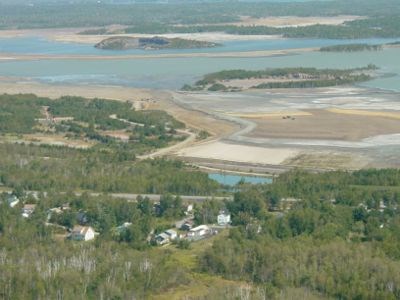The steep cost of a biosolids facility, which would treat the city's biosolid sludge, the waste left over after sewage was treated at the city's nine treatment plants, had city councillors sending staff to find ways to afford the project.
With a 2012 deadline looming, city council tackled the issue of how to pay for the plant that would deal with the sludge.
For more than 30 years, the city has been dumping the sludge in a Vale Inco tailing pond in Lively, an inexpensive way of dealing with the waste. Vale Inco will no longer allow the sludge to be dumped into tailing ponds by the end of 2012.
The sludge dumped into tailing ponds is produced by nine wastewater treatment plants, a report from city engineering services explained. In the past several years, residents in Lively and Waters have been able to smell the waste if the wind blew from the right direction.
“The odours (caused by the tailings) are not new to Lively residents,” Ward 2 Coun. Jacques Barbeau said. “This (dumping into a pond) may have seemed like a good idea 30 years ago, but it is not acceptable now.”
According to city staff and their consultants, other municipalities have been investing for decades in sewage sludge treatment technologies, such as digestion processes where high temperatures kill the pathogens in the sludge.
“Sudbury has no digestion process,” Shawn Scott, an engineer with Dennis Consultants, said. “We didn't invest in it, we just dumped it.”
But when some councillors were reminded of the price tag of $30 to $40 million for the biosolids facility, which would treat the sludge and turn it into something usable, they balked.
“I am concerned about the costs,” Ward 8 Coun. Ted Callaghan said. “This is a major expense. It has implications for the tax levy.”
He warned a project of this size could drive the city "into the ditch" financially, and suggested staff come back to council with a better analysis of where the money could be found to pay for it.
To date, the city has only set aside $3.6 million from previous years' budgets for the facility.
"The game is over as of 2012," Barbeau warned, insisting the city has to go forward with the biosolids project, despite the cost. "We will have no place to put it. Are we going to dump it in our backyards?”
Ward 1 Coun. Joe Cimino said it was time for council to "bite the bullet."
“We are eons behind in how we deal with our waste," he said. "For the past 30 years we spent nothing other than the haulage costs.”
Prior to the council meeting on April 28, Ward 3 Coun. Claude Berthiaume raised concerns about the possibility the facility would be privately operated. He noted the experiences of other communities with this arrangement were not good.
“This sounds like a private public partnership project," Berthiaume said at city council. "Sid Ryan from CUPE presented council with a binder of examples from other communities where this was tried.”
He said in those cases outlined by Ryan, communities were stuck with facilities that were poorly maintained after the private sector backed out of managing them. Costs to city wastewater users also increased over time when the facilities were not owned and operated by the city, he said.
Join Sudbury.com+
- Messages
- Post a Listing
- Your Listings
- Your Profile
- Your Subscriptions
- Your Likes
- Your Business
- Support Local News
- Payment History
Sudbury.com+ members
Already a +member?
Not a +member?
Sign up for a Sudbury.com+ account for instant access to upcoming contests, local offers, auctions and so much more.
